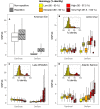Widespread Deviant Patterns of Heterozygosity in Whole-Genome Sequencing Due to Autopolyploidy, Repeated Elements, and Duplication
- PMID: 38085037
- PMCID: PMC10752349
- DOI: 10.1093/gbe/evad229
Widespread Deviant Patterns of Heterozygosity in Whole-Genome Sequencing Due to Autopolyploidy, Repeated Elements, and Duplication
Abstract
Most population genomic tools rely on accurate single nucleotide polymorphism (SNP) calling and filtering to meet their underlying assumptions. However, genomic complexity, resulting from structural variants, paralogous sequences, and repetitive elements, presents significant challenges in assembling contiguous reference genomes. Consequently, short-read resequencing studies can encounter mismapping issues, leading to SNPs that deviate from Mendelian expected patterns of heterozygosity and allelic ratio. In this study, we employed the ngsParalog software to identify such deviant SNPs in whole-genome sequencing (WGS) data with low (1.5×) to intermediate (4.8×) coverage for four species: Arctic Char (Salvelinus alpinus), Lake Whitefish (Coregonus clupeaformis), Atlantic Salmon (Salmo salar), and the American Eel (Anguilla rostrata). The analyses revealed that deviant SNPs accounted for 22% to 62% of all SNPs in salmonid datasets and approximately 11% in the American Eel dataset. These deviant SNPs were particularly concentrated within repetitive elements and genomic regions that had recently undergone rediploidization in salmonids. Additionally, narrow peaks of elevated coverage were ubiquitous along all four reference genomes, encompassed most deviant SNPs, and could be partially associated with transposons and tandem repeats. Including these deviant SNPs in genomic analyses led to highly distorted site frequency spectra, underestimated pairwise FST values, and overestimated nucleotide diversity. Considering the widespread occurrence of deviant SNPs arising from a variety of sources, their important impact in estimating population parameters, and the availability of effective tools to identify them, we propose that excluding deviant SNPs from WGS datasets is required to improve genomic inferences for a wide range of taxa and sequencing depths.
Keywords: autopolyploid; heterozygosity; paralog; repetitive DNA; salmonid; whole-genome sequencing.
© The Author(s) 2023. Published by Oxford University Press on behalf of Society for Molecular Biology and Evolution.
Figures






References
-
- Benjamin A, Sağlam İK, Mahardja B, Hobbs J, Hung TC, Finger AJ. Use of single nucleotide polymorphisms identifies backcrossing and species misidentifications among three San Francisco estuary osmerids. Conserv Genet. 2018:19(3):701–712. 10.1007/s10592-018-1048-9. - DOI
Publication types
MeSH terms
LinkOut - more resources
Full Text Sources
Miscellaneous

